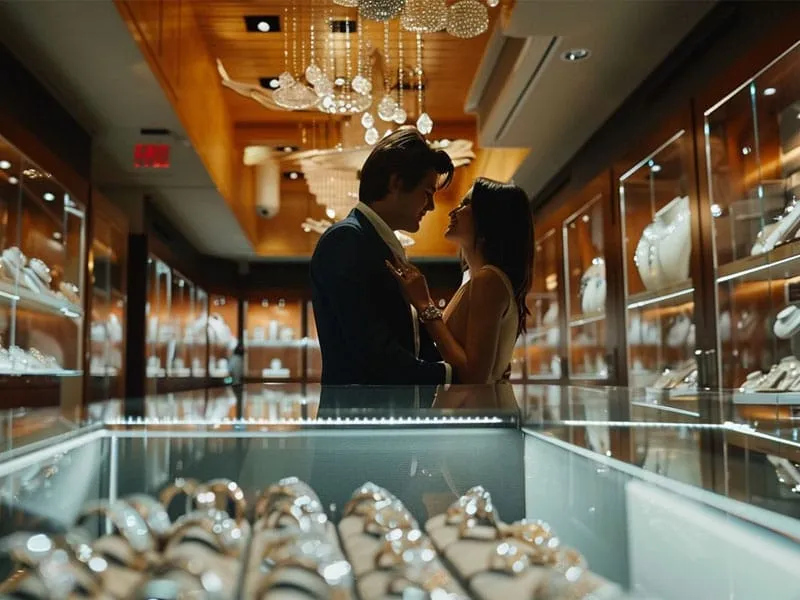
The Ultimate Guide To Information You Should Have Before Engagement Ring Shopping
Picking out an engagement ring can feel like a mission impossible.
The Gemological Institute of America & the Team at Nelson Estate Jewelers says there’s a lot to consider.
This article will guide you through the essentials, making the process simpler and less stressful.
You can always stop by our jewelry store in Mesa, AZ and we’ll be happy to answer any questions you have.
Key Takeaways
- Learn about your fiancée’s ring preferences, such as style and metal type, before shopping.
- Set a budget for the engagement ring to avoid unexpected expenses and understand hidden costs.
- Understand the significance of the 4Cs (cut, color, clarity, carat) in choosing a diamond.
- Decide between natural and lab-grown diamonds based on values and budget.
- Consider alternative stones or custom designs for a unique engagement ring.
Understanding Your Partner’s Preferences
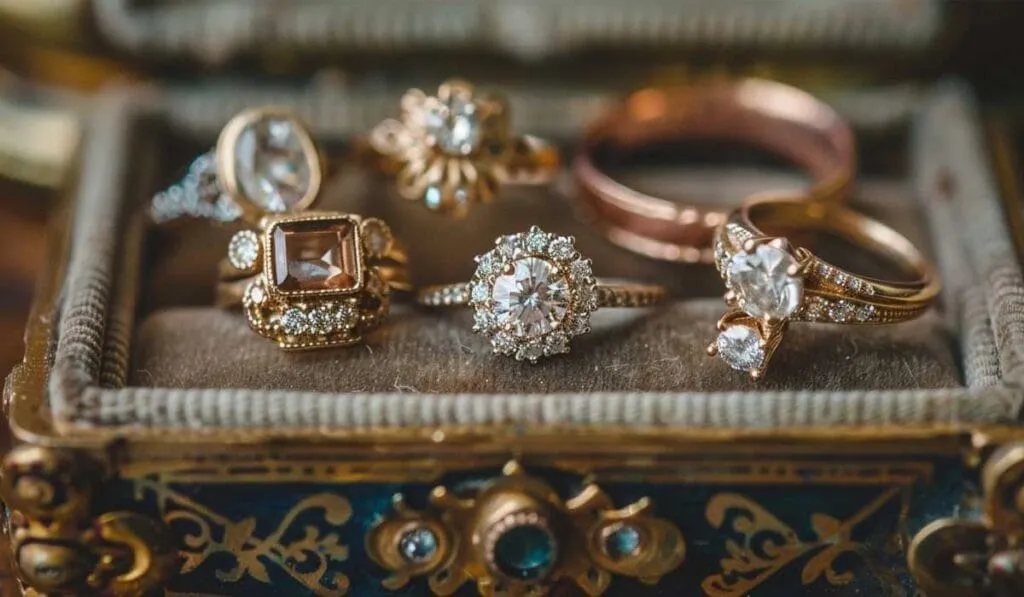
Finding out what your partner loves in a ring is like picking the perfect movie for movie night.
You’ve got to know whether they’re into classics like “Breakfast at Tiffany’s” or something modern, maybe with a twist of sci-fi.
Preferred styles and settings
Your fiancée’s dream engagement ring is out there. First, you’ve got to know what she likes.
Let’s break it down:
- Solitaire Setting: The iconic single diamond on a band. It’s timeless, lets the diamond shine, and says “I love you” without saying a word.
- Halo Setting: A center stone surrounded by smaller diamonds. This setting makes the main diamond look bigger and adds sparkle.
- Pavé Setting: The band is lined with tiny diamonds. It’s all about the bling and making that finger light up.
- Three-Stone Setting: Represents past, present, and future. It’s sentimental and can be customized with different stone shapes.
- Vintage-Inspired Settings: Think intricate designs from the past—Art Deco or Victorian. Perfect for someone who loves a story behind their style.
- Twisted or Braided Band: Symbolizes two lives coming together as one—a beautiful metaphor for marriage.
- Bezel Setting: The diamond is fully encircled by metal, making it secure and modern-looking at the same time.
- Split Shank Band: Where the band splits into two before meeting the central diamond—dramatic and stylish.
- Asscher Cut Diamond: Known for its deep clarity and almost octagonal shape—a striking choice for lovers of vintage glam.
- Pinterest Board Ideas: Not exactly a setting, but creating a board together can give you both inspiration and clear direction.
- Gemological Institute of America (GIA) Grading Report: While shopping, ask if the diamond comes with a GIA report—this certificate provides peace of mind about your investment.
- Breakfast at Tiffany’s Moment: Sometimes it’s not just about the ring but also about how you present it—make it memorable!
- Lab-Grown Diamonds vs Traditional Diamonds: Some prefer lab-grown for ethical reasons; others want traditional stones with centuries-old legacy—know what she values most.
- Alternative Stones Like Moissanite or Silicon Carbide: They’re almost as hard as diamonds but budget-friendlier—they shine bright like diamonds too!
- Custom Design Possibilities: If off-the-shelf isn’t her thing, think about designing a ring together with a jeweler—it doesn’t get more personal than that.
Each option tells a story…
Your job? Find out which story your fiancée wants to tell with her engagement ring!
Favorite metal types
Picking the right metal for an engagement ring is crucial. It’s about matching your fiancée’s style and ensuring the ring lasts a lifetime. Here’s a quick guide to help you choose:
- Gold: Classic, timeless, and available in various hues—yellow, white, and rose. Yellow gold is the traditional choice for wedding bands and engagement rings, offering a warm glow that complements diamonds beautifully. White gold, coated with rhodium for extra shine and durability, offers a cooler tone that pairs well with all gemstones. Rose gold, with its pinkish hue, brings a unique, romantic feel to any ring design.
- Platinum: This metal screams luxury and is known for its durability and hypoallergenic properties. Platinum’s natural white sheen won’t fade or change color over time, making it perfect for those who want their ring to maintain its look without extra maintenance.
- Silver: While more affordable than gold or platinum, silver requires more upkeep as it tarnishes easily. Its cool luster makes it a popular choice for those seeking a modern look on a budget.
- Palladium: Similar to platinum but lighter and less expensive. Palladium is also hypoallergenic and has a natural white color that doesn’t require rhodium plating.
- Titanium: Known for being incredibly strong yet surprisingly lightweight, titanium offers a modern look at an affordable price point. Its dark gray color provides a distinctive alternative to traditional metals.
Each metal type offers something different in terms of appearance, maintenance needs, and cost—factors worth considering before making your final pick.
The Importance of Knowing Your Budget
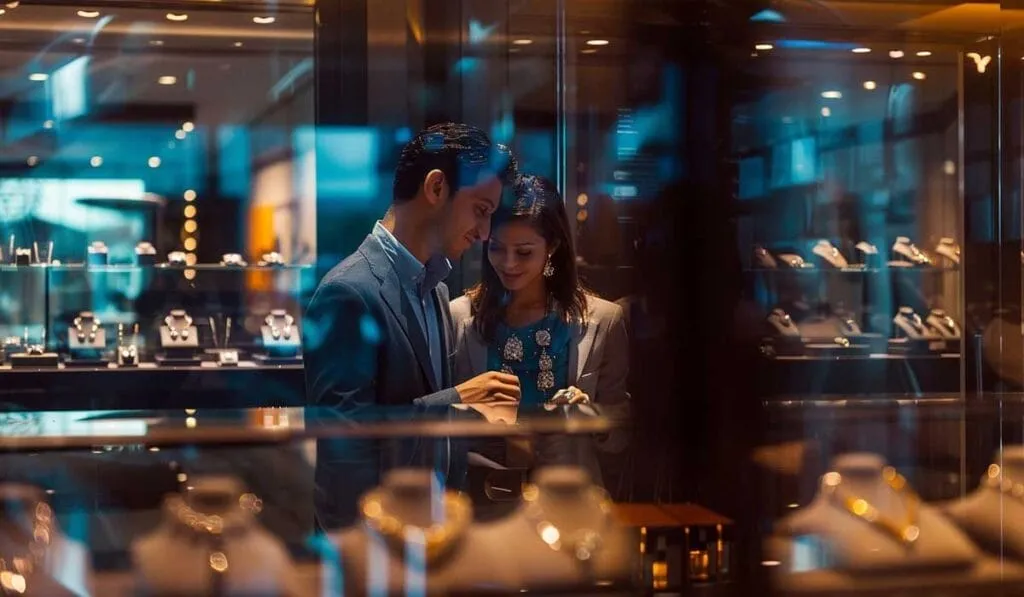
Before you start looking at shiny rings, know what you can spend. Setting a budget keeps surprises away and lets you focus on the best options within your reach…
Establishing a spending limit
Setting a budget for your engagement ring should be step one. It’s like picking the right suit; you don’t want to go overboard, but you also want to look sharp. Think of your spending cap as a safety net that keeps you from falling into a financial pit.
This isn’t just about slapping down cash or swiping your card; it’s about planning for a future together. So, crack open that piggy bank and see what’s inside before dreaming too big.
Now, let’s talk hidden costs because they’re sneaky little things that can catch you off guard. Sales tax, warranty extensions, or resizing fees can inflate your final bill like a balloon at a birthday party.
And if we’re getting fancy with diamond certification from places like GIA grading, add that to the tab too. Factoring these into your initial budget means no ugly surprises later on…
…except maybe her face when she sees how perfect the ring is!
Hidden costs in ring purchasing
Surprise fees can sneak up on you during engagement ring shopping, and don’t forget to look into engagement ring insurance. Think sales tax, insurance costs, or resizing expenses—it all adds up. Plus, if you’re opting for a custom design, prepare to shell out extra for that personal touch.
And let’s not forget shipping and handling if you go the online route. These are just a few examples of how your budget might stretch beyond the price tag on that flawless ring.
The Significance of the 4Cs
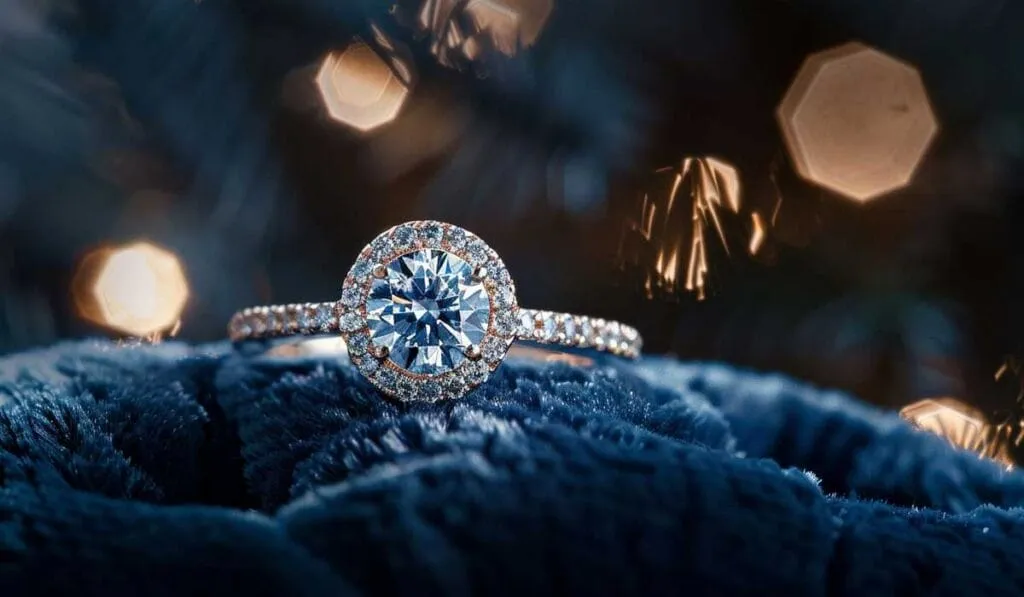
The 4Cs are like the backbone of choosing a sparkler. They help you pick a stone that shines just right and fits your budget.
Cut
Cut defines how well a gem sparkles. Think of it like the secret sauce that makes an engagement ring shine. A good cut captures light and reflects it, making your fiancée’s hand a show-stopper.
Graduate gemologists say, “A diamond’s cut is crucial.” It’s all about angles and proportions. Too shallow or too deep, and the stone loses its fire.
The sparkle in her eyes should match the sparkle on her finger.
Go for a high-quality cut within your budget rather than going big on size alone. Size isn’t everything if the rock doesn’t have that brilliance she loves. Whether you’re eyeing a classic round brilliant or something more modern like an oval or marquise, keep this in mind: A well-cut diamond outshines them all.
Color
Color in a diamond is like the soul of your favorite song. It sets the mood and allure. Diamonds come in a rainbow of colors, from icy white to warm yellows. Most folks aim for that perfect white, but a hint of color can add character without breaking the bank.
Think about it like choosing between classic black-and-white photos versus ones with a splash of sepia—it’s all about the vibe you’re going for.
Even slightly colored diamonds could sparkle just as bright to an untrained eye, especially under romantic dinner lights or sunlight at their favorite park.
So don’t sweat if you can’t snag the purest color out there; what matters is how it shines when you pop the question.
Clarity
Think of clarity in a diamond like its passport to brilliance. The fewer the blemishes and inclusions, or tiny imperfections, the more it shines. This doesn’t mean you need a flawless gem to make jaws drop.
Even diamonds with some marks can catch light beautifully if they’re cut well.
Choosing between different clarity grades depends on what catches your eye and fits your budget. A lab-grown diamond can offer stunning clarity at a more approachable price than natural ones do.
So, if sparkle without breaking the bank sounds good, this might be your best bet…
Carat
After talking about clarity, let’s dive into carat weight. Carat is like the heavyweight champion of the diamond world. It talks about how much a diamond weighs, not how big it looks.
More carats mean a heavier gem and usually, a heavier price tag too. Think of it as the more slices of pizza you want, the more you’ll have to pay.
A handy tip: bigger isn’t always better. A huge rock might grab attention, but its sparkle depends on cut and clarity too. Don’t just chase after high carats because they sound impressive.
Sometimes, a smaller stone with better clarity can outshine a larger one that’s flawed.
Finding the perfect engagement ring is all about balance – size matters, but so does quality.
Lab-grown diamonds offer an interesting choice here – they can be less costly for more carat weight compared to their natural cousins. So if your fiancée dreams big but you’re watching your budget, this could be your ace in the hole.
Deciding Between Natural and Lab-Grown Diamonds
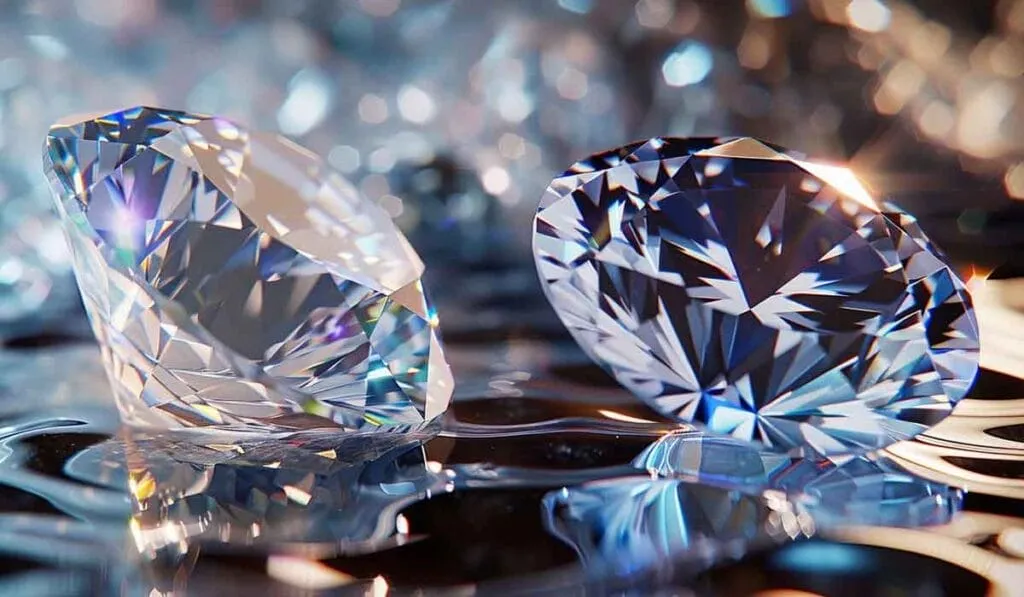
Picking between earth-made and science-created diamonds is a big deal. Earth-made ones come from deep underground, while scientists make the other kind in a lab.
Both sparkle, but they have different stories and price tags.
Think about this choice like deciding between a classic ice cream flavor and an exciting new taste – both are sweet, but your pick depends on what brings you joy… or maybe on how thick your wallet is!
Benefits of each type
So, you’re stepping into rings, diamonds, and all that sparkles to find the perfect engagement ring for your fiancée.
You’ve got a lot to think about! Let’s talk about natural versus lab-grown diamonds. Both have their perks, and figuring out which one can get you the best bang for your buck is crucial.
Here’s a simple breakdown:
| Aspect | Natural Diamonds | Lab-Grown Diamonds |
|---|---|---|
| Creation Process | Forged over billions of years beneath the Earth’s crust. | Created in a lab over weeks using cutting-edge technology. |
| Price | Generally more expensive due to their natural rarity and mining costs. | Typically 20-30% less expensive than natural diamonds of similar quality. |
| Environmental Impact | Higher, due to the mining process. Requires large amounts of earth to be removed. | Lower, as it avoids the massive mining operations. |
| Value Retention | Historically holds value better over time. | May depreciate more quickly than natural diamonds. |
| Romantic Appeal | Some see the long formation process as a metaphor for enduring love. | Others appreciate the modernity and ethical sourcing. |
| Quality | Varies greatly. Some are flawless, others less so. | Can be programmed for high quality, including color and clarity. |
Choosing the right stone isn’t just about the specs, though. It’s about the story you want to tell. Think about what resonates more with your relationship and partner’s values.
Is it the timeless journey of a natural diamond, or the innovative, eco-friendly approach of lab-grown gems? Your heart—and your wallet—will guide you in the right direction.
Also, keep in mind, this ring is a symbol, a promise. Make it count.
Alternative Stones and Customization Options
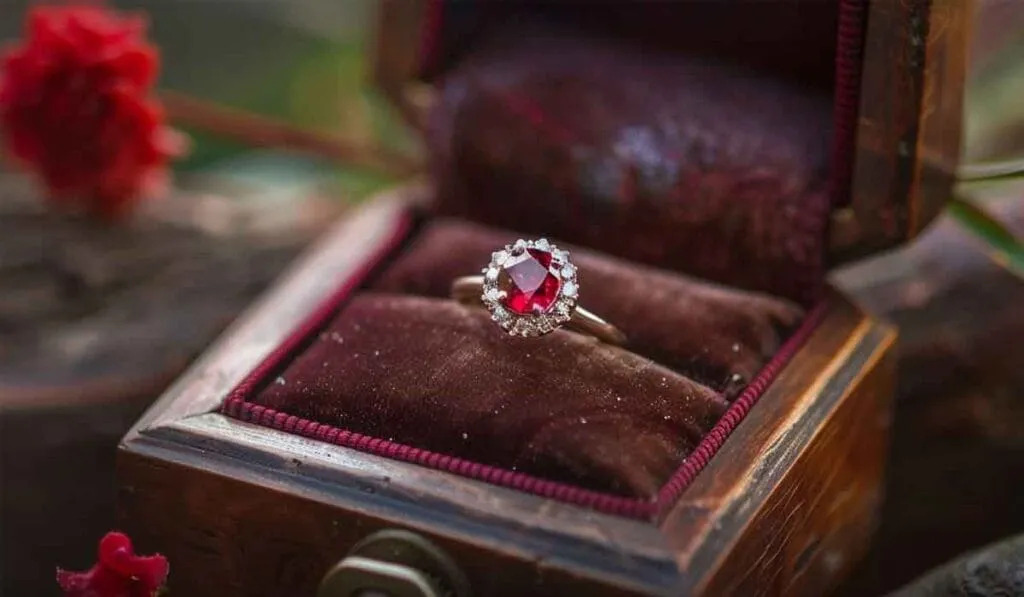
Diamonds are not the only game in town. Think about sapphires, rubies, or even custom designs that show off her style.
Popular alternatives to diamonds
Shopping for an engagement ring doesn’t always mean picking out a diamond. Many couples now look at alternatives that are just as stunning but offer unique character and often more affordability.
- Moissanite: This gemstone is nearly as hard as diamonds, making it perfect for everyday wear. It’s known not just for its durability but also for its sparkling brilliance which can outshine many other stones.
- Sapphires: Often associated with royalty (think Princess Diana’s famous engagement ring), sapphires come in various colors besides the iconic blue – from yellow to green, offering a colorful twist to traditional engagement rings.
- Emeralds: With their rich green hue, emeralds offer a vintage feel. They’re softer than diamonds, so they need a bit of extra care. However, their unique color makes them stand out as an elegant choice.
- Rubies: Symbolizing love and passion, rubies make a bold statement with their deep red color. They’re almost as tough as sapphires and moissanites, ensuring your ring lasts through the years.
- Opals: These stones are known for their play-of-color, flashing rainbow hues when hit by light. Each opal is one-of-a-kind due to this characteristic, guaranteeing a special ring.
- Pearls: Classic and timeless, pearls bring a soft beauty to any engagement ring setting. While they’re more delicate compared to other gems on this list, pearls evoke elegance like no other.
Each option has its charm and benefits making your engagement ring shopping an adventure of choices beyond traditional boundaries.
Custom design possibilities
Moving away from traditional stones opens up endless possibilities for custom ring designs to flourish.
Thinking outside the box lets you craft an engagement ring that’s as unique as your love story.
Note: We custom design beautiful engagement rings all the time and the cost is inline with what the big box stores charge for their showroom rings…
Imagine choosing a stone that matches her eyes or designing a setting that mirrors her personality—options abound. Opt for engravings, unusual stone shapes, or even incorporating symbols that mean something special to both of you.
If it can be imagined, it can be created, said every jeweler exploring custom designs. The journey of picking out materials—be it gold, silver, or platinum—and pairing them with lab grown diamonds or other gemstones is nothing short of exciting.
You’re not just buying an engagement ring; you’re creating a piece of art that represents your bond. Take advantage of technology like 3D modeling to preview and tweak your design until it’s perfect. This approach isn’t just about getting it right; it’s about making something truly one-of-a-kind.
Importance of Ring Sizing and Timing
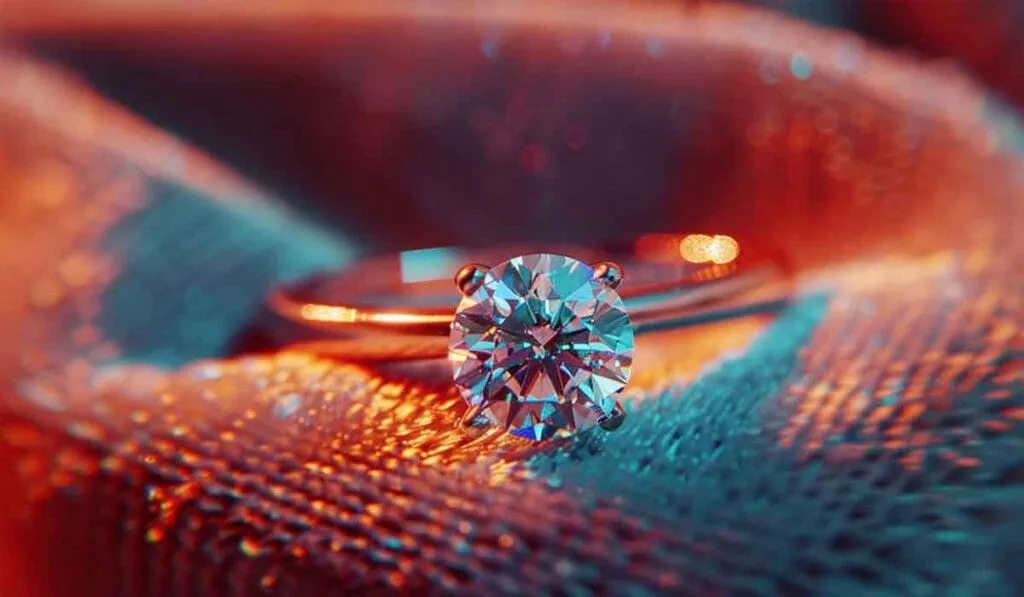
Getting the right ring size is like hitting a bullseye. It’s got to fit just right, or it’s a miss. And don’t forget about timing! You want that ring ready for the big moment, not stuck in a shop getting sized.
How to secretly find out her ring size
Shopping for an engagement ring comes with its own set of covert missions. One of the trickiest? Figuring out her ring size without blowing your cover.
Here’s how to pull off this top-secret task:
- Borrow one of her rings. Wait for a moment when she’s not looking, and grab a ring she often wears on her ring finger. Just make sure it’s from the correct hand! Jewelers can measure this and give you the perfect fit.
- Recruit a friend or family member. Someone close to her might already know her ring size. If not, they can help get it – maybe by taking her shopping and having her try on rings “just for fun.”
- Play detective with her jewelry box. If borrowing isn’t an option, trace the inside of one of her rings on paper or press it into a bar of soap for an impression. Your jeweler can work with that.
- Use an online guide. There are printable guides that show how to match a current ring to find its size.
- Go for adjustable sizes if all else fails. Some jewelers offer rings that can adjust several sizes, either way, providing flexibility if your guess is off mark.
- Sneak in a sizer during sleep – This move requires stealth but slipping a sizer onto her finger while she’s asleep could work…if she’s a heavy sleeper!
- Ask indirectly about jewelry preferences…without being obvious – Strike up conversations about style preferences in jewelry and see if you can guide the discussion toward sizes without making her suspicious.
- Compare fingers discreetly – While holding hands, compare the size of one of your fingers to hers; it might give you a ballpark figure if you’re close in hand size.
- Opt for slightly larger – If you’re unsure, choosing a slightly larger size is safer because resizing smaller is often easier than going bigger.
- Embrace the surprise element – Make guessing part of the adventure; it shows effort and thought went into choosing the perfect engagement ring.
Each step offers its challenge but getting that perfect fit means going above and beyond—just like your commitment to each other!
Understanding lead times for ring creation
Crafting an engagement ring takes a little time.
We shoot for one month from start to finish.
Let’s break it down—choosing the design comes first.
Your next step is selecting stones and metals. After that, jewelers need time to work their magic, turning raw materials into a beautiful ring for your fiancée.
I once waited too long to order a custom piece and had to choose something off the shelf last minute—not ideal. Learn from my mistake. Start early, especially if you want something special made just for her.
Jewelers suggest starting at least two months before you plan to propose. This gives them enough time to create and adjust the ring without rushing.
Rush orders are possible but can cost you extra bucks…money that could have gone toward a honeymoon or wedding expenses!
Should You Shop Together?
Shopping for an engagement ring can be a shared journey or a solo mission. It’s like choosing between watching a movie alone or turning it into date night – both have their perks.
Pros and cons of shopping as a couple
Deciding to go ring shopping together is a big step. It’s like choosing what flavor of ice cream to get – except a lot more expensive and lasts a lifetime. Here’s a quick rundown of what to expect:
| Pros | Cons |
|---|---|
| You know she’ll love it because she picked it out. | Takes away the element of surprise. |
| It can be a bonding experience. | Could spoil the romantic “pop the question” moment. |
| She gets exactly what she wants, from the cut to the color. | Pressure might make the decision harder. |
| No guesswork about her ring size. | Less of a personal achievement for you. |
| Open discussion about budget. | Might lead to disagreements in front of sales staff. |
Conclusion
So, you’re about to take the plunge and look for that perfect engagement ring. Exciting, right? But hang on – make sure you’ve got your homework done first. Know what she loves, from the sparkle of her favorite gems to the band that will make her swoon.
And yes, don’t forget your wallet’s limit! Diamonds? They’re vast and shiny – cut, color, clarity, and size matter here. Thinking between a diamond born from the earth or one made in a lab? Each shines bright in its own way.
And if diamonds aren’t her thing, no sweat – there are plenty of stones and styles that can capture her heart just as well.
Sneakily figuring out her ring size could be your next secret mission; timing is key too since crafting these beauties takes time.
Wondering if you should bring her along for the ride? Well, that depends on both of you. Shopping together might just be the cherry on top of this exciting journey!
FAQs
1. What size should the engagement ring be?
Before you dive into the sea of sparkly rings, know your partner’s ring size. It’s like finding Cinderella’s shoe; it has to fit just right. You can play detective with a ring they already wear or ask their friends if they’re good at keeping secrets.
2. What style does your fiancée love?
Some like it bold, others prefer the classics. Peek through their jewelry box or notice what catches their eye in a store window. Remember, this ring is more than metal and stone; it tells their story.
3. How much should I spend on an engagement ring?
Forget those old sayings about spending months of salary on a ring. Your budget should feel right for you without breaking the bank. Love doesn’t have a price tag, after all.
4. Should I know about different types of stones and metals before shopping?
Absolutely! Diamonds might be forever, but there are other gems in the sea—sapphires, rubies, emeralds—you name it! And let’s not forget the band: gold, silver, platinum? Each shines in its own way.




